Life is unpredictable and sometimes customers need to make changes to their original plans. In order to offer this convenience to customers, I worked on enabling customers to do things, like make changes to their order, themselves.

Photo by Paul Hanaoka on Unsplash
At cinch the only way a customer was able to make an amend to their order was to call, email or message the customer service team. This meant that the customer service teams were constantly taking calls and spending time resolving requests. Lots of requests coming through also meant that customers weren't always able to get through to customer service and / or had to wait for long periods before getting through. Additionally, lots of requests coming through also meant the time taken to resolve requests took longer. Sometimes the customer service team also required development squads to action requests too, which added to the time to resolve.
For customers, experiencing delays in getting through to customer service and delays getting requests actioned, meant this wasn't the most convenient way to amend their order. Therefore we had an opportunity to find more convenient ways for customers to make changes to their order at the click of a button, without needing to wait to get through to customer service.
Discovery
To begin, I looked at all the customer requests that were coming into the customer service team. I then worked with the data team to understand the frequency of different requests and the time it took to resolve, this was in order to create prioritised list of areas to focus on. Common customer requests included asking to reschedule a delivery date, changing a delivery type, removing their part exchange from their order, canceling an order and requesting a return.
One of the most common requests that took a lot of effort and time for teams to resolve was the rescheduling of customers delivery dates. Therefore, the team decided to focus on this as a priority. In order to design a service for customers to do this themselves, I needed to understand how reschedule requests are currently actioned by teams today. To do this, I started to learn more about the current customer experience.
From looking at customer service data, customers were mainly requesting a reschedule due to changes in work, health or family commitments meaning they are now not being available on their original delivery date. Another common reason was that during pre delivery calls, customers would be informed that they needed to have certain documents, like a V5, ready for their delivery but often couldn't find them. This would lead to customers needing to request documents from the DVLA which could take up to 5 days, meaning their delivery needed to be rescheduled. Whilst I was still in discovery, I was able to feed back this insight to the team in order to look at opportunities to better inform customers of what documents they needed to avoid rescheduling.
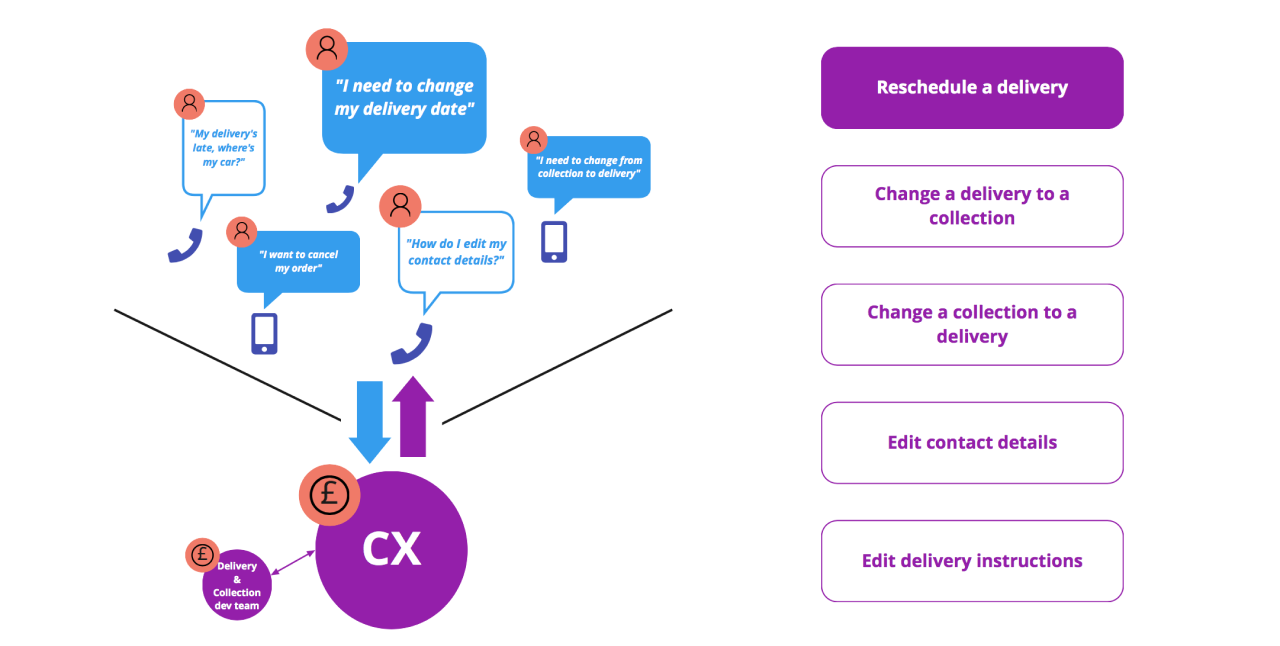
A collection of self serve opportunities in the delivery space

Data used to learn more about customer behaviours
In order to design the service for customers being able to reschedule themselves online, I needed to discover current processes and requirements. To do this, I facilitated sessions with all the business areas involved in dealing with reschedules (including customer service and logistics teams). The sessions involved me virtually mapping out steps with team members, whilst anecdotally gaining insight into pain points and requirements.
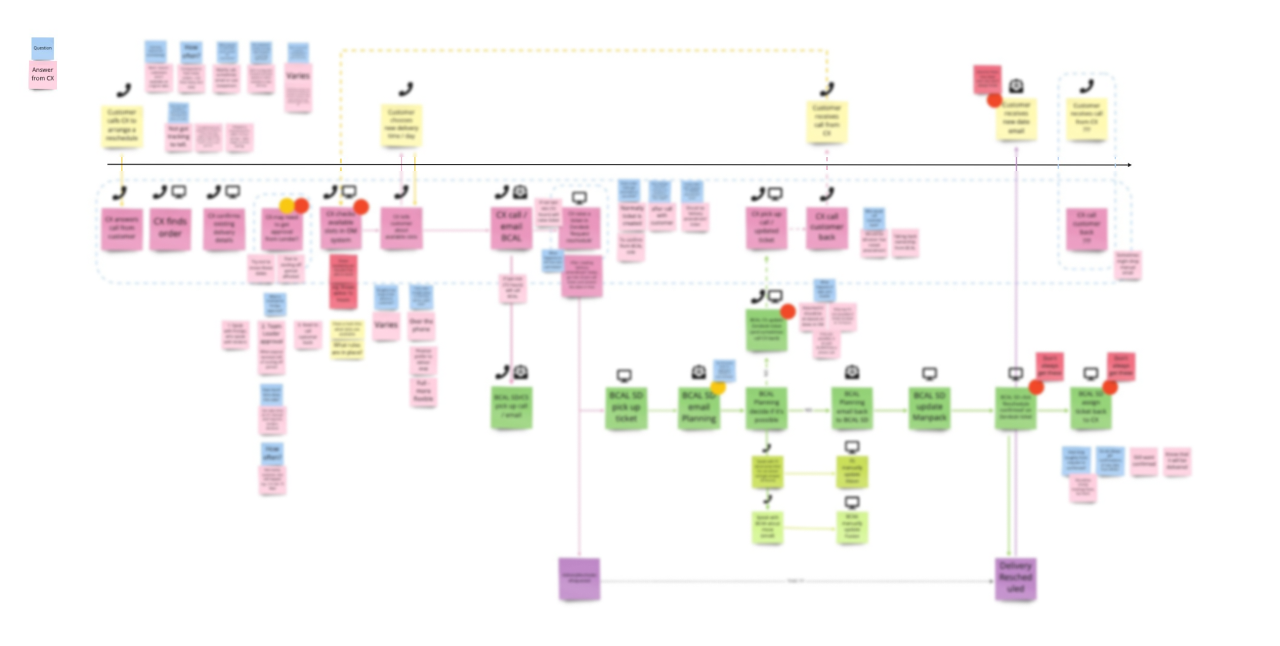
Map of the current service with notes added from staff mapping workshop
Define
After collating insights across the varying business areas, I was able to piece together a picture of how the service currently worked to create a current state map. Layering on insight, I was able to also understand and visually communicate pain points in the current service, including lots of steps, manual processes, emails back and forth to customers, handovers between teams, time to get confirmation, logistical planning to check if a new date is possible.
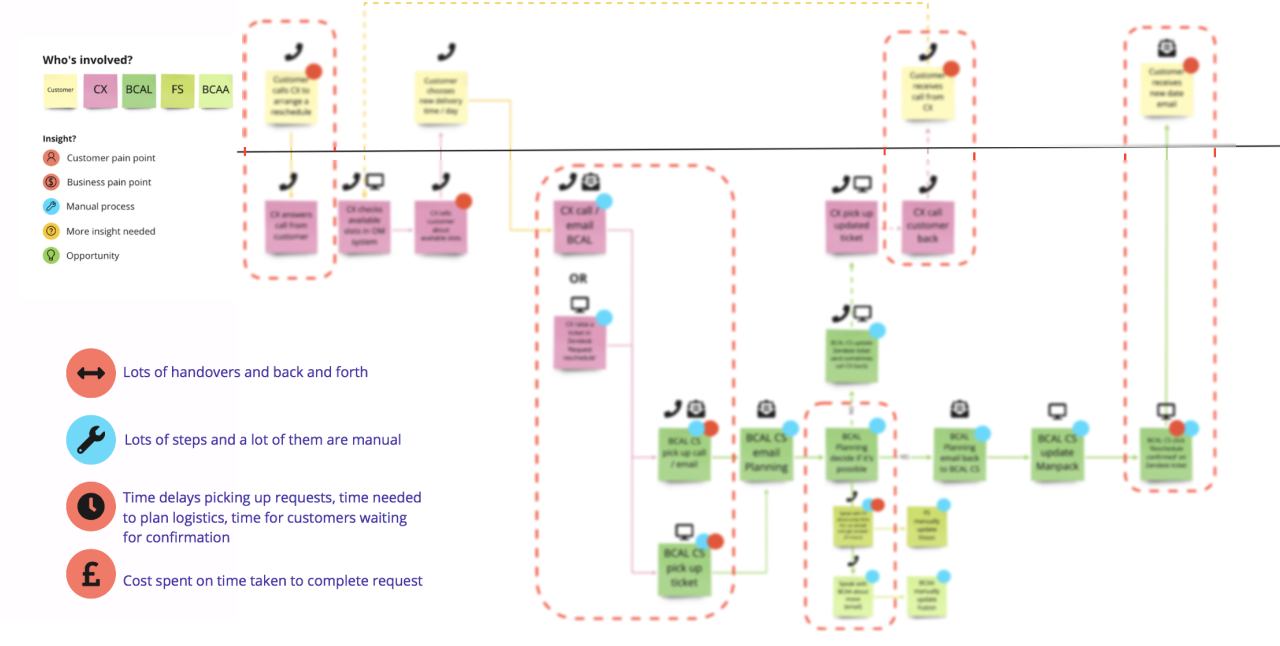
Map of the current service, with insight layered on
At high level, key opportunities were to allow customers to self serve rescheduling their deliveries to reduce the time and effort needed to be spent by the customer service and logistic teams, but also whilst building out this feature to improve the service behind it for improved operational efficiencies.
To help inform the product team on insights and discovery, I put in weekly playback sessions with the team. This enabled all members of the team (including both engineers and user experience designers) to ask further questions and help direct which areas we needed to focus on. As most of the product team was also new to service design practices, this also helped me educate and take the team on a journey of how methodologies helped move the piece of work forward.
Design
Understanding the current process and current pain, helped me drive towards designing a vision for the new service, that would improve the experience for both customers and the business. I collaborated with the team to prototype the service with high level mapping and iterated to keep driving towards a seamless, smooth experience using minimal manual processing and handovers between teams.
By using virtual post it notes to map out the vision service, I was able to keep ideas flexible so we could be divergent in thinking and not restricted. Continuously playing back the vision map with the squad (engineers, PO and design team) helped drive the work from discovery into delivery through prototyping testing and technical spikes.
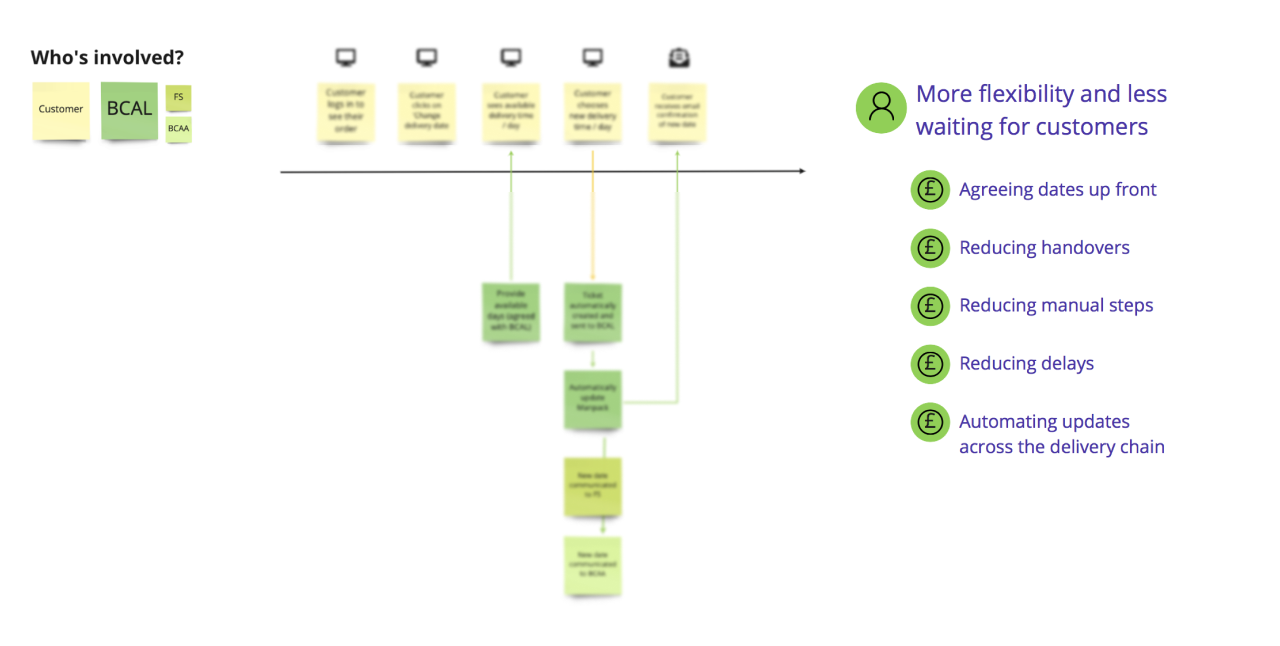
Vision service design for a self serve rescheduling of a delivery
Focusing on opportunities across the full service
Designing a solution for self serve reschedules, enabled the development of other opportunities across the full service, from ordering to ownership and all in between. All with a vision to remove the faff of waiting to get through to CX and instead allow customers to make changes and take action themselves. Plus, saving teams delivering the service time and energy resolving requests and allowing them to focus on delivering a great experience to customers.
Opportunities across the service for customers to self serve instead of calling ranged from providing as much information about vehicles as possible by accessing vehicle databases to allowing a customer to raise a fault with their vehicle.
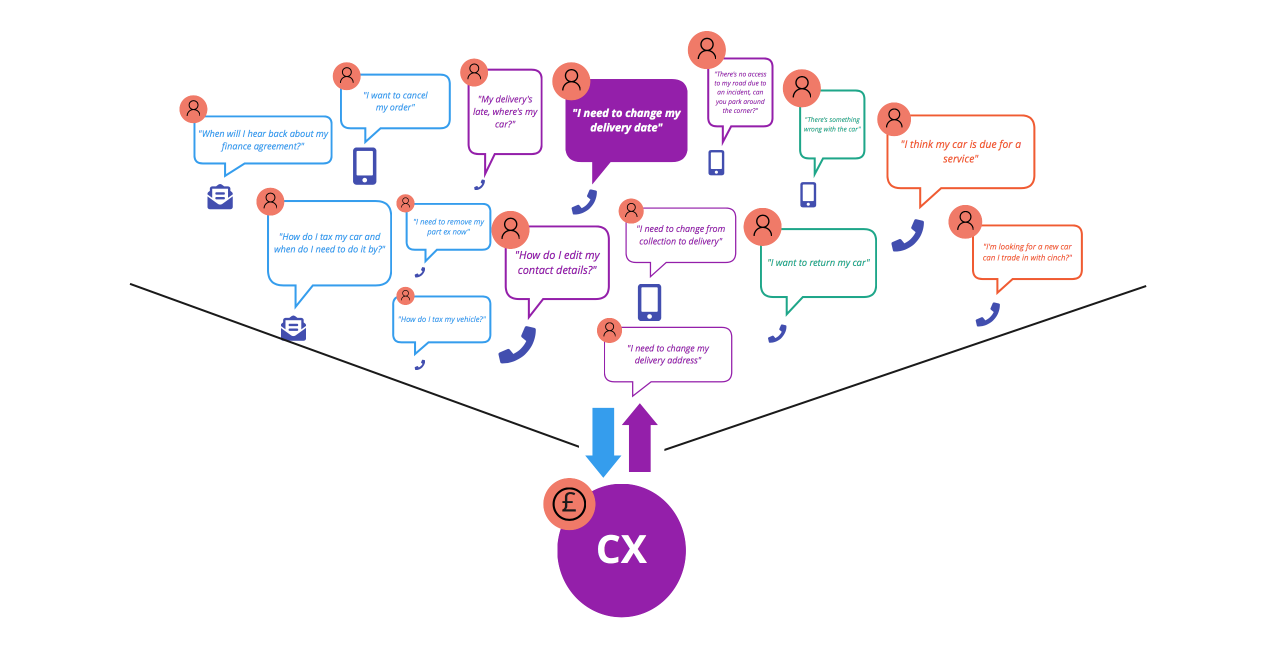

Turning queries and requests into CX to self serve opportunities across the service
With lots of opportunities for customers to self serve across the service, we also discovered there was an opportunity for these requests to be housed within an online account area for customers to access at any time.
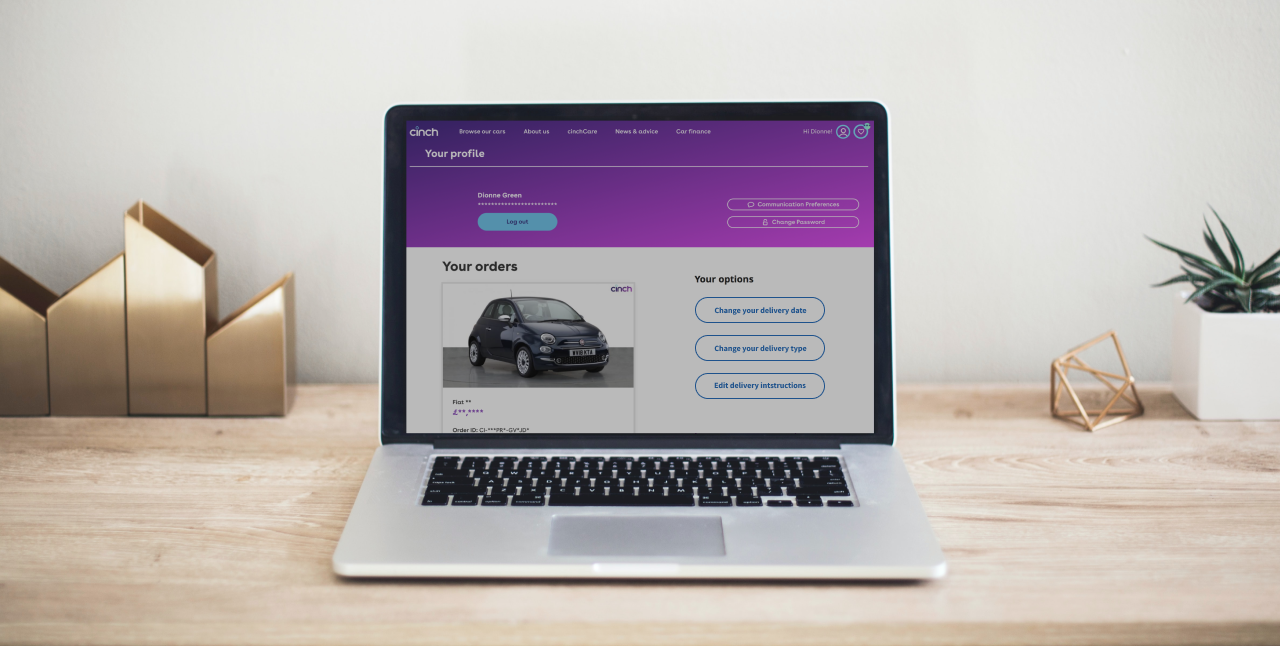
Delivery
To deliver the new service, I worked across multiple teams including the Delivery & Collections squad, Customer Account squad and Customer Experience squad to bring the visions to life. From collaborating on defining the first iteration of the service to go live and learn from, to helping build out prototypes to test with customers before going live, I used the current service mapping and vision map to drive conversations with designers and engineers.
I also encouraged cross collaboration across different squads to ensure all sections of the service were tied up and not operating in silo. To do this, I played back learnings and maps to different teams and highlighted where key dependencies were on a weekly basis.
Results
As I write this, the vision for all self serve opportunities, has now been added to multiple squad backlogs and teams are currently building out these features. Our customer service team had already championed how much value this feature will add by removing the time and effort taken to action these requests and allow the team to focus on improving the customers overall experience instead.